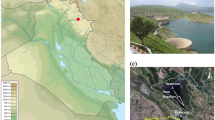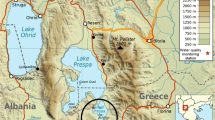Abstract
Water is a prime necessity for the survival and sustenance of all living beings. Over the past few years, the water quality of rivers is adversely affected due to harmful wastes and pollutants. This ever-increasing water pollution is a big matter of concern as it deteriorating the water quality, making it unfit for any type of use. Recently, water quality modelling using machine learning techniques has generated a lot of interest and can be very beneficial in ecological and water resources management. However, they suffer many times from high computational complexity and high prediction error. The good performance of a deep neural network like long short-term memory network (LSTM) has been exploited for the time-series data. In this paper, a deep learning–based Bi-LSTM model (DLBL-WQA) is introduced to forecast the water quality factors of Yamuna River, India. The existing schemes do not perform missing value imputation and focus only on the learning process without including a loss function pertaining to training error. The proposed model shows a novel scheme which includes missing value imputation in the first phase, the second phase generates the feature maps from the given input data, the third phase includes a Bi-LSTM architecture to improve the learning process, and finally, an optimized loss function is applied to reduce the training error. Thus, the proposed model improves forecasting accuracy. Data comprising monthly samples of different water quality factors were collected for 6 years (2013–2019) at several locations in the Delhi region. Experimental results reveal that predicted values of the model and the actual values were in a close agreement and could reveal a future trend. The performance of our model was compared with various state of the art techniques like SVR, random forest, artificial neural network, LSTM, and CNN-LSTM. To check the accuracy, metrics like root mean square errors (RMSE), the mean absolute error (MAE), mean square error (MSE), and mean absolute percentage error (MAPE) have been used. Experimental analysis is carried out by measuring the COD and BOD levels. COD analysis reveals the MSE, RMSE, MAE, and MAPE values as 0.015, 0.117, 0.115, and 20.32, respectively, for the Palla region. Similarly, BOD analysis indicates the MSE, RMSE, MAE, and MAPE values as 0.107, 0.108, 0.124, and 18.22, respectively. A comparative analysis reveals that the proposed model outperforms all other models in terms of the best forecasting accuracy and lowest error rates.








Similar content being viewed by others
References
Adimalla N (2019) Groundwater quality for drinking and irrigation purposes and potential health risks assessment: a case study from semi-arid region of South India. Exposure Health 11(2):109–123
Ahmed U, Mumtaz R, Anwar H, Shah AA, Irfan R, García-Nieto J (2019) Efficient water quality prediction using supervised machine learning. Water 11(11):2210
Anand, A., & Suganthi, L. (2020). Forecasting of electricity demand by hybrid ANN-PSO models. In Deep Learning and Neural Networks: Concepts, Methodologies, Tools, and Applications (pp. 865-882). IGI Global.
Avila R, Horn B, Moriarty E, Hodson R, Moltchanova E (2018) Evaluating statistical model performance in water quality prediction. J Environ Manag 206:910–919
Bisht, A. K., Singh, R., Bhatt, A., & Bhutiani, R. (2017). Development of an automated water quality classification model for the River Ganga. In International Conference on Next Generation Computing Technologies (pp. 190-198). Springer, Singapore.
Chatterjee S, Sarkar S, Dey N, Ashour AS, Sen S, Hassanien AE (2017) Application of cuckoo search in water quality prediction using artificial neural network. Int J Comput Intel Stud 6(2-3):229–244
Hu Z, Zhang Y, Zhao Y, Xie M, Zhong J, Tu Z, Liu J (2019) A water quality prediction method based on the deep LSTM network considering correlation in smart mariculture. Sensors 19(6):1420
Huang, M., Tian, D., Liu, H., Zhang, C., Yi, X., Cai, J. … & Ying, G. (2018). A hybrid fuzzy wavelet neural network model with self-adapted fuzzy-means clustering and genetic algorithm for water quality prediction in rivers. Complexity, 2018.
Kadam AK, Wagh VM, Muley AA, Umrikar BN, Sankhua RN (2019) Prediction of water quality index using artificial neural network and multiple linear regression modelling approach in Shivganga River basin, India. Model Earth Syst Environ 5(3):951–962
Kisi O, Parmar KS (2016) Application of least square support vector machine and multivariate adaptive regression spline models in long term prediction of river water pollution. J Hydrol 534:104–112
Li X, Cheng Z, Yu Q, Bai Y, Li C (2017) Water-quality prediction using multimodal support vector regression: case study of Jialing River, China. J Environ Eng 143(10):04017070
Li L, Jiang P, Xu H, Lin G, Guo D, Wu H (2019) Water quality prediction based on recurrent neural network and improved evidence theory: a case study of Qiantang River, China. Environ Sci Pollut Res 26(19):19879–19896
Liao, F., & Zhao, C. (2016). Water quality prediction model based on fuzzy neural network. In 2016 6th International Conference on Machinery, Materials, Environment, Biotechnology and Computer. Atlantis Press.
Liu P, Wang J, Sangaiah AK, Xie Y, Yin X (2019) Analysis and prediction of water quality using LSTM deep neural networks in IoT environment. Sustainability 11(7):2058
Liu J, Yu C, Hu Z, Zhao Y, Bai Y, Xie M, Luo J (2020) Accurate prediction scheme of water quality in smart mariculture with deep Bi-S-SRU learning network. IEEE Access 8:24784–24798
Lu H, Ma X (2020) Hybrid decision tree-based machine learning models for short-term water quality prediction. Chemosphere 249:126169
Moon J, Kim Y, Son M, Hwang E (2018) Hybrid short-term load forecasting scheme using random forest and multilayer perceptron. Energies 11(12):3283
Mukate S, Panaskar D, Wagh V, Muley A, Jangam C, Pawar R (2018) Impact of anthropogenic inputs on water quality in Chincholi industrial area of Solapur, Maharashtra, India. Groundw Sustain Dev 7:359–371
Panaskar DB, Wagh VM, Muley AA, Mukate SV, Pawar RS, Aamalawar ML (2016) Evaluating groundwater suitability for the domestic, irrigation, and industrial purposes in Nanded Tehsil, Maharashtra, India, using GIS and statistics. Arab J Geosci 9(13):615
Parmar KS, Bhardwaj R (2014) Water quality management using statistical analysis and time-series prediction model. Appl Water Sci 4(4):425–434
Quan, Q., Hao, Z., Xifeng, H., & Jingchun, L. (2020). Research on water temperature prediction based on improved support vector regression. Neural Comput Appl, 1-10.
Rahman, A., Dabrowski, J., & McCulloch, J. (2019). Dissolved oxygen prediction in prawn ponds from a group of one step predictors. Information Processing in Agriculture.
Samantaray, S., Tripathy, O., Sahoo, A., & Ghose, D. K. (2020). Rainfall forecasting through ANN and SVM in Bolangir Watershed, India. In Smart Intelligent Computing and Applications (pp. 767-774). Springer, Singapore.
Shahid F, Zameer A, Muneeb M (2020) Predictions for COVID-19 with deep learning models of LSTM, GRU and Bi-LSTM. Chaos, Solitons Fractals 140:110212
Unnikrishnan P, Jothiprakash V (2020) Hybrid SSA-ARIMA-ANN model for forecasting daily rainfall. Water Resour Manag 34(11):3609–3623
Wang, Y., Zhou, J., Chen, K., Wang, Y., & Liu, L. (2017). Water quality prediction method based on LSTM neural network. In 2017 12th International Conference on Intelligent Systems and Knowledge Engineering (ISKE) (pp. 1-5). IEEE.
Yahya A, Saeed A, Ahmed AN, Binti Othman F, Ibrahim RK, Afan HA, Elshafie A (2019) Water quality prediction model based support vector machine model for ungauged river catchment under dual scenarios. Water 11(6):1231
Yaseen ZM, Ehteram M, Sharafati A, Shahid S, Al-Ansari N, El-Shafie A (2018) The integration of nature-inspired algorithms with least square support vector regression models: application to modeling river dissolved oxygen concentration. Water 10(9):1124
Yasin, M. I., & Karim, S. A. A. (2020). A new fuzzy weighted multivariate regression to predict water quality index at Perak rivers. In Optimization based model using fuzzy and other statistical techniques towards environmental sustainability (pp. 1-27). Springer, Singapore.
Ye, Q., Yang, X., Chen, C., & Wang, J. (2019). River water quality parameters prediction method based on LSTM-RNN model. In 2019 Chinese Control and Decision Conference (CCDC) (pp. 3024-3028). IEEE.
Zhang, L., & Xin, F. (2018). Prediction model of river water quality time series based on ARIMA model. In International Conference on Geo-informatics in Sustainable Ecosystem and Society (pp. 127-133). Springer, Singapore.
Acknowledgements
The authors thank CPCB, New Delhi, for providing Yamuna river water quality data.
Availability of data and materials
The data that support the findings of this study are available from the Central Pollution Control Board, New Delhi, India, but restrictions apply to the availability of these data, which were used under license for the current study and so are not publicly available. Data are however available from the authors upon reasonable request and with permission of the Central Pollution Control Board.
Author information
Authors and Affiliations
Contributions
SK implemented the methodology and prepared the manuscript with the guidance of NS (PhD supervisor).
Corresponding author
Ethics declarations
Ethics approval and consent to participate
NA
Consent for publication
NA
Conflict of interest
The authors declare no competing interests.
Additional information
Responsible Editor: Xianliang Yi
Publisher’s note
Springer Nature remains neutral with regard to jurisdictional claims in published maps and institutional affiliations.
Rights and permissions
About this article
Cite this article
Khullar, S., Singh, N. Water quality assessment of a river using deep learning Bi-LSTM methodology: forecasting and validation. Environ Sci Pollut Res 29, 12875–12889 (2022). https://doi.org/10.1007/s11356-021-13875-w
Received:
Accepted:
Published:
Issue Date:
DOI: https://doi.org/10.1007/s11356-021-13875-w




